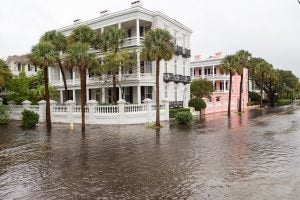
Addressing Gaps in Disaster Recovery for South Carolina Households through Inclusive Insurance Models
This blog was authored by Environmental Defense Fund economists, Karina French and Carolyn Kousky. See their report here.
South Carolina is no stranger to the devastating effects of extreme flooding, with hurricanes like Matthew and Florence leaving a trail of destruction in their wake. As the state faces escalating flood risk due to climate changes and continued building in vulnerable areas, it is crucial to address existing gaps and inequities in disaster recovery. In a new report, we provide a comprehensive review of the current resources available to households for post-disaster economic recovery in South Carolina and explore the extent to which innovative disaster insurance policy designs can fill these gaps and improve equity in recovery.
The Current State of Economic Recovery
Severe floods can have significant financial consequences, particularly for low-income individuals and communities of color who lack access to adequate financial support systems. The existing resources for economic recovery, including savings, loans, federal aid, and insurance, often fall short in meeting the needs of these vulnerable groups. Insufficient and inaccessible funds, delays in accessing recovery funds, inadequate support for renters and rural areas, and unaffordable disaster insurance for low-income households all further exacerbate recovery challenges.
The Role of Inclusive Insurance
While insurance plays a crucial role in improving recovery outcomes, many of those who need it the most lack access to it. Inclusive insurance initiatives for climate disasters can build a system that is affordable, accessible, transparent, people-centered, and just. Implementing inclusive insurance requires regulatory changes, new public policies, partnerships, and innovative risk transfer approaches.
This report explores two new insurance designs that have gained attention as potential solutions to improving recovery outcomes and enhancing equity: microinsurance and group disaster insurance.
Microinsurance offers affordable baseline disaster coverage with low-cost premiums. Microinsurance benefits include affordability, fast payments, reduced documentation burdens, and the potential to increase trust among marginalized communities. However, limitations such as limited payout amounts and potential ineligibility for FEMA assistance should be considered.
Group disaster insurance involves an intermediary institution that facilitates insurance coverage for a group of households or individuals, ensuring wider take-up and creating an easier approach for cost-sharing. Group disaster insurance benefits include expanding those with financial protection, tailored support, cost-sharing opportunities, and incentives for community-level risk reduction. Challenges include the capacity of intermediaries and ongoing affordability concerns.
Charting a Path Forward for South Carolina
Both microinsurance and group disaster insurance have the potential to address the recovery needs in South Carolina by broadening coverage, enhancing affordability, and tailoring solutions to specific needs. However, regulatory structures and implementation strategies must be carefully considered. In our previous study titled “Inclusive Insurance for Climate-Related Disasters: A Roadmap for the United States,” EDF and Ceres highlighted the insufficient coverage provided by the national U.S. insurance industry for climate-related disasters. This new report released in May 2023 builds upon the prior national perspective and focuses specifically on South Carolina’s recovery needs, States across the country, however, are facing similar climate-related challenges and could also learn from this analysis.
The Importance of Comprehensive Approaches
While there is no one-size-fits-all solution to address the gaps and inequities in disaster recovery, understanding the current challenges and exploring innovative insurance tools can inform conversations and shape tailored solutions. South Carolina’s vulnerability to climate-related disasters, including coastal and inland flooding, necessitates robust recovery strategies. Enhancing financial recovery also needs to be complemented by other programs to reduce underlying risk and improve risk awareness.
By embracing inclusive insurance models and implementing targeted policies, South Carolina can bolster its resilience and ensure economic stability for all communities in the face of future disasters. We hope to see the insights from this report serve as valuable guidance for other states nationwide that are also grappling with similar climate-related challenges.











